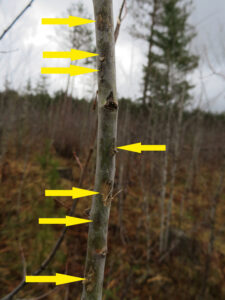
A young aspen shows signs of severe impact from hail. Arrows indicate each point of impact. / Photo Credit: Wisconsin DNR
By Linda Williams, DNR Forest Health Specialist, Woodruff
Linda.Williams@wisconsin.gov, 920-360-0665
Several high-impact storms across the state this summer have pummeled trees with hail. The photos accompanying this article show the kind of damage hail can bring to forests.
The initial damage following a significant hailstorm can immediately appear severe. But give it a month or two, and the damage can look even more pronounced.
Pines in particular will start to turn varying levels of brown, depending on the amount of damage they sustained. Damage to the branches and twigs is not limited to just the spot where the hail hit. As the summer goes on, damaged areas of bark that were cracked by the hail impact will often split open further and allow more drying and additional separation of the bark from the wood, which kills that area of the branch.
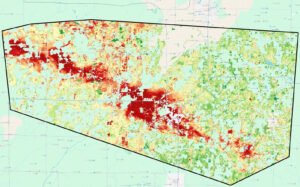
A map created by Sarah Wegmueller of Silvicart Geospatial Data Analysis, showing where damage developed along the path of a hailstorm on July 19, 2025. Red areas show areas most severely impacted across Lincoln, Marathon, and Shawano counties. / Graphic Credit: Sarah Wegmueller, Silvicart Geospatial Data Analysis
Red pine branches and twigs that are damaged by hail can also be invaded by Diplodia, a fungal disease that can kill the branch tips and even whole branches. Blue stain can quickly move into this damaged red pine as well. Blue stain is generally undesirable and can reduce the value of the timber, although there is a niche market for small amounts of blue-stained lumber. White pine can also develop blue stain.
Hardwoods that are peppered with hail damage can also show significant dieback, but they tend to be able to respond more positively than red pine.
Hail damage that occurs in the spring, versus the summer or fall, will impact trees differently, including when the symptoms will become obvious. Hot or droughty periods shortly after the hail damage occurs can put trees under further stress and can make it difficult for those trees to recover. Most tree species have an insect or disease that can take advantage of stressed trees, such as Armillaria root disease in many tree species, bark beetles in pines, Diplodia in red pine, twolined chestnut borer in oak, bronze poplar borer in aspen, bronze birch borer in birch … and the list goes on.
Salvage harvests, particularly in red pine, may be necessary in stands where more than 50% of the crown has turned brown due to damage by the hail directly or by Diplodia infection after the hailstorm. White pine and other conifers may need to be salvaged, too, if they begin to brown out.
Monitor damaged conifers for bark beetle attacks in the summer following the storm, as well as the following year. Stressed red pine can be attacked by Ips bark beetles and may kill these damaged red pine.
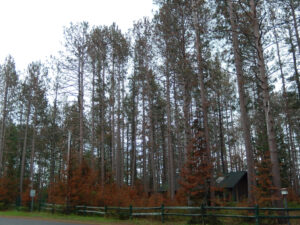
After a hailstorm that occurred in the fall of the year, understory trees were severely impacted. Overstory trees were stripped of foliage, twigs were badly damaged. Trees with this level of damage may not be able to recover or will take many years to recover. / Photo Credit: Wisconsin DNR
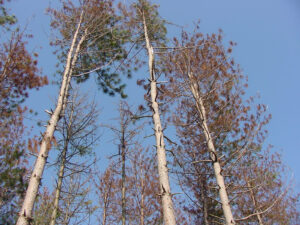
The disease Diplodia has attacked many shoots on these red pine trees that were damaged by hail. These trees will not survive. / Photo Credit: Wisconsin DNR
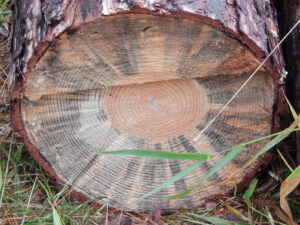
Blue stain fungus has invaded hail wounds on a red pine tree that was damaged by hail. This staining can occur quickly after a storm and reduces the value of the timber. / Photo Credit: Wisconsin DNR
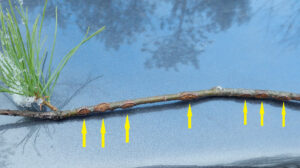
A white pine twig that was previously damaged by hail. The tree has grown over and closed all the wounds (yellow arrows). / Photo Credit: Wisconsin DNR
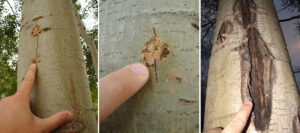
The photos at left and center are wounds on aspen bark, taken within a month of a hailstorm. Wounds have dried and the bark has cracked. The photo at right is from the same area on the tree, six years later, showing that as the wounds dried, they expanded before the tree could start to grow over them. / Photo Credits: Wisconsin DNR
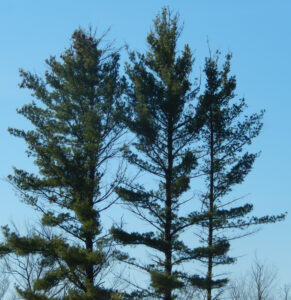
The tops of three white pine trees, showing many dead branches three years after a severe hailstorm. / Photo Credit: Wisconsin DNR
